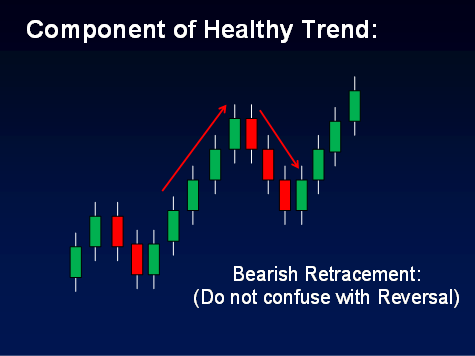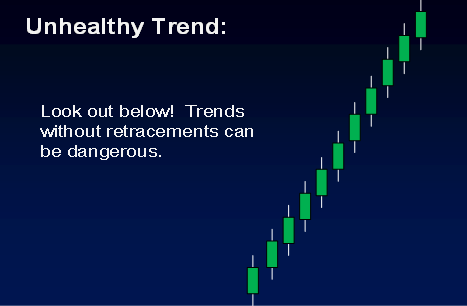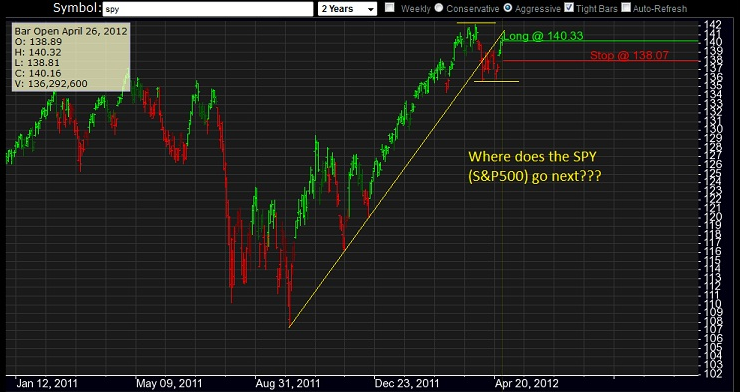 By: Chris Irvin, Veteran Instructor & Trader at The Wizard
By: Chris Irvin, Veteran Instructor & Trader at The Wizard
When we are looking a social media and pop culture it seems that trends change by the minute. I read recently that the seniors leaving collage this year believe that email is dead. It is essentially the snail mail of the 21st century and has been replaced by texting. Waiting for an email response just takes too long. As I get older, it takes me longer to identify trends, and I often miss the signals that they are coming to an end. Just ask my kids – they will agree with me.
When it comes to the stock market some people suffer from the same difficulties. They cannot see the market trends and have a tough time seeing the signals that those trends are coming to an end. This is a critical skill in the trading world. The truth is that everything is trending. It does not matter if you trade stocks, currencies or futures, in some timeframe there will be an observable trend.
In this blog we are going to discuss the definition of a trend, and more importantly how to recognize the difference between “Retracements” and ”Reversals.”
What is a Trend?
To make things easy let’s work with only bullish (upward moving) trends in the beginning. Our foundation is going to be the definition of a bullish trend. A bullish trend is “a series of higher highs and higher lows.” If a stock, or the market in general, is trending in a bullish fashion it does not mean that every tick must be to the upside. There will be movements both up and down within a bullish trend. The example below may be a bit too symmetrical but it is a good visual of a bullish trend.

As long as the stock price moves above the previous high, and does not move below the most recent low, the stock remains in a Bullish Trend. In the chart below you can see that real life may not be as symmetrical as my previous example, but the higher highs and higher lows still stand out. (COF is not a buy sell or hold recommendation, it is being used as an example only to learn to identify bullish trends. The Chart is from The Wizard)

Trading with the trend is the safest way to trade.
If a stock is in great demand, the trend will be up. Consider the trend as the path of least resistance. The traders that decide to trade against the trend will constantly feel like they are running on a treadmill, never getting anywhere; like they are driving the wrong way on a one way street; like they are swimming upstream. You get the point, right? Understanding that trading with the trend is the safest way to trade is a huge step towards becoming a successful trader. This is why at The Wizard I only teach trading strategies that agree with the trend.
In “Technical Analysis of Stock Trends 9th Edition,” pg. 51,, Edwards, Magee, and Bassetti wrote “Clearly the way to reduce market risk to zero is to be out of the market. Less obviously, or perhaps blatantly, the second most important way to reduce risk is to be right the trend …
Retracements -the right time to enter a position.
Stocks, and the market in general, can become tired of moving in the same direction. It takes a lot of work, and money, to send a stock to higher highs. When the price breaks to a new high, it is not unusual for the buying pressure to run out of steam. When demand dries up, price begins to fall and causes the chart to head south. This causes the stock to become more appealing to prospective buyers who believed the stock has potential to move higher but were not willing to pay top dollar. Essentially they were waiting for the stock to go “on sale” before they make a purchase. As the price becomes more appealing at a lower point, these savvy buyers step in creating demand and once again the price begins another leg higher. What I have just described is a “retracement.” Retracements are healthy functions of a solid trend and they are an exellent time to enter a position on a trending stock.

How to recognize when a trend is unhealthy.
If a trend continues too long in the same direction (over extended), it runs the risk of a collapse. When trends collapse investors lose big-time.


Reversals: How to know when a trend is over.
Since the definition of a trend is “a series of higher highs and higher lows,” then, logically speaking, the trend has to be over when the stock fails to establish a higher high and sets a lower low instead. You cannot have a lower low in a bullish trend.

In the example above, you can see that after the retracement (healthy part of a trend) the stock was unable to push to a higher high. Instead the stock rolled over and created a lower high. A lower high is unhealthy, but it is not the end of the bullish trend. It is possible that after setting a lower high the stock could retrace again, never setting a lower low, and then push above the previous high to a higher high. The nail in the coffin of a bullish trend is the establishment of the lower low. Once the lower low is in place your trend is over. This is called a “Reversal.”
If we look closer at our FRX example we can see that the stock when through this progression as it ended it upward trend. A high of $40.52 was set on June 22, 2011. FRX then pulled back to a low of $39.11 on June 27th before starting to climb higher. On July 7th it reached a lower high of $40.35. It could go no higher. When to stock broke below the previous low of $39.11 on July 11th, the bullish trend was broken and FRX was experiencing a reversal.

Putting this blog to good use…
The SPY has a similar look to FRX in the days of it move up without a retracement. It will be important that it set a new high above its March 30th high of 141.05. If it does not, and instead breaks below its previous low of $137.84 on April 9th, SPY would be looking at a major reversal. Until it breaks below $137.84 SPY is still bullish.

Every trader fights their emotions. Using logical rules to identify trends, retracements and reversals can help you get a grip on those emotions and make you a more successful trader.
Regards,
Chris Irvin
Try The Wizard’s Market Trend Indicator for free. Click here and sign-up in the upper right-hand corner of the web site

Chris,
Thank you for the explenation!
That looks very interesting.
I Took a copy and I will try to translate it in my language Dutch to understand a little better